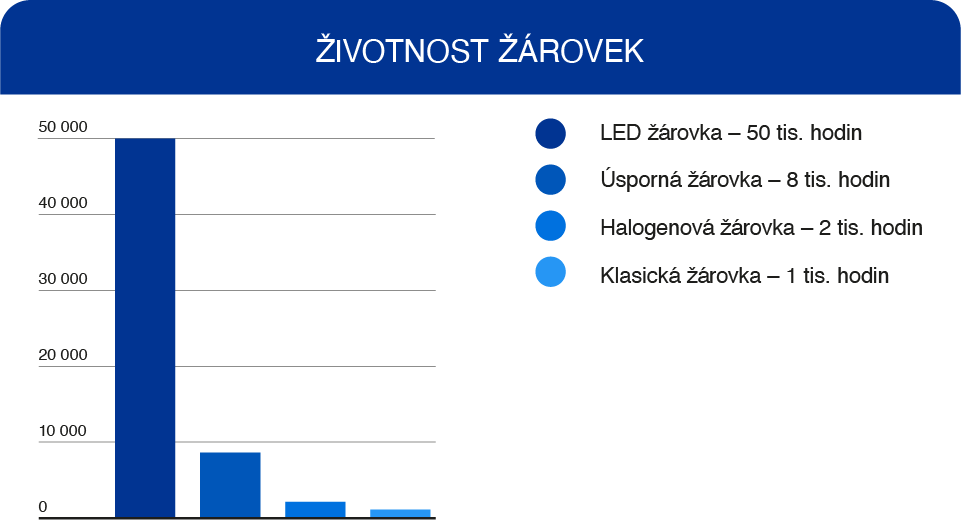TESLAbikář or how to choose the right LED bulb
Part 8 LED bulb lifetime and switching cycle
 Long lifetime is one of the biggest advantages often presented in connection with LED bulbs. So what is their lifespan? The lifetime of conventional bulbs has generally been quoted as 1000-2000 hours of illumination. While the average value for an LED bulb for domestic use is given as 25 000 hours, but some sources have a lifetime of up to 50,000 hours. What glows in an LED bulb is the chip. And it is this chip that carries the quality of the colour rendering, the efficiency of the illumination and also its lifetime. LED chips don't stop shining even after their lifetime, they just gradually lose "power". Their lifetime is stated in thousands of hours, as long as the LED chip's luminance is higher than 70 % of the original luminance.
Long lifetime is one of the biggest advantages often presented in connection with LED bulbs. So what is their lifespan? The lifetime of conventional bulbs has generally been quoted as 1000-2000 hours of illumination. While the average value for an LED bulb for domestic use is given as 25 000 hours, but some sources have a lifetime of up to 50,000 hours. What glows in an LED bulb is the chip. And it is this chip that carries the quality of the colour rendering, the efficiency of the illumination and also its lifetime. LED chips don't stop shining even after their lifetime, they just gradually lose "power". Their lifetime is stated in thousands of hours, as long as the LED chip's luminance is higher than 70 % of the original luminance.

LED BULBS SAVE YOU TIME AND MONEY
 Clearly, LED bulbs have a much longer lifespan and therefore we don't have to buy them as often as we used to with conventional bulbs. In addition, TESLA lighting tests its LED bulbs in its own photometric laboratory and therefore provides a warranty on its LED bulbs 3 year extended warrantyky.
Clearly, LED bulbs have a much longer lifespan and therefore we don't have to buy them as often as we used to with conventional bulbs. In addition, TESLA lighting tests its LED bulbs in its own photometric laboratory and therefore provides a warranty on its LED bulbs 3 year extended warrantyky.
WHAT ABOUT ECOLOGY?
All those who are responsible to our environment will appreciate that LED bulbs are more energy efficient. They also contain no toxic substances, lead, mercury, etc. They do not emit any ultraviolet or infrared radiation. Therefore, they clearly contribute to creating a healthier working and personal environment.

ON - OFF
Do you have small children? Then you must be familiar with the popular light switch game, where grandparents tell their kids they're going to ruin their light bulb. Turning a light on and off is defined as a switching cycle and tells us how many times a light can be turned on and off again. LED bulbs don't mind frequent on/off switching or short shining, their lifetime is not significantly shortened by this. For TESLA lighting LED bulbs, the switching cycle is in the range of 10 000 - 20 000x. We can also mention here the fact that the LED bulb almost immediately after switching on is lit at full power.
HOW TO DISPOSE OF LED BULBS
We call on everyone to behave responsibly and manage waste responsibly. If we don't care where our household waste ends up, we will do our best to sort it out, and this doesn't just apply to LED bulbs. LED bulbs can be well recycled, electronic components can be reused and materials such as metal, glass or plastic can be recovered. It is therefore worth taking LED bulbs preferably to a collection yard. They can also be taken to other collection points, but they can also be disposed of in an e-waste container, where shards can make handling difficult.
We already know that LED bulbs keep on shining even after their lifetime and that they can be recycled well, so sorting waste makes sense in this case.

